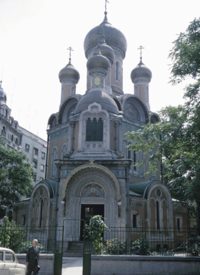
The AP teamed with German investigative reporters from the public television network ARD, and the German newspaper Sueddeutsche Zeitung in conducting the investigation that allegedly discovered the so-called black site.
Reportedly, former CIA operatives led the reporters to the building. In fact, the AP story states that "former intelligence officials both described the location of the prison and identified pictures of the building."
"Black sites" is the name given to the officially unconfirmed network of secret prisons located throughout the world used by the CIA to imprison and interrogate individuals suspected of committing or conspiring to commit terrorist activities.
These facilities are built outside of the jurisdiction of the U.S. government and thus not subject to American laws against torture.
Persons accused by the U.S. government of being "enemy combatants" were subject to "extraordinary rendition" and then captured and shipped off to one of the prisons for questioning, where the detainees were often reportedly subjected to inhuman tactics to illicit responses from them.
The existence of the Romanian location, while never confirmed by the government of the United States, the CIA, or the government of Romania, was part of a report adopted by the European Parliament in 2007. The document listed 1,245 flights operated by the CIA in the area, especially into and out of Poland and Romania.
The building in Bucharest reported to be the former CIA holding facility was used to detain Khalid Sheik Mohammad, as well as other "high-profile terrorists" before they were shipped off to Guantanamo Bay.
Among the other suspected terrorists believed to have been confined in the Romanian prison was Walid bin Attash (accused of participating in the bombing of the USS Cole) and Abu Faraj al-Libi, the reputed source of the name of Osama bin Laden’s courier.
Mohammad was arrested in Pakistan in 2003 and has been held at Guantanamo Bay since 2006. He has yet to be tried on the charges that he masterminded the attacks of September 11, 2001.
President George W. Bush admitted the existence of the secret prisons in 2006, the same year they were supposedly shuttered and all the inmates transferred to Guantanamo.
After that, it was reported that the policy of maintaining the sites was abandoned in 2009.
Predictably, the government of Romania denies any knowledge of activity of the U.S. government at the building suspected of being the prison and the CIA will not comment on the story.
The building itself, a rather nondescript beige one-story building on the outskirts of Bucharest, is home to the Office of the National Register for Secret State Information (ORNISS). This Romanian government agency manages and stores classified material from the United Nations and NATO.
When asked by one of the German reporters if the building was ever used to torture terrorists, ORNISS deputy head Adrian Camarassan replied, "Here? No! Impossible! Impossible!"
Camarassan did confirm that the basement of the ORNISS building was "one of the most secure rooms," but that it was never used by American intelligence to detain or torture suspected terrorists.
One of the former CIA employees who supposedly led reporters to the site confirmed the secrecy of the goings on, explaining that, "It was very discreet there. It was not as though Romanian officials came out to greet me."
A former U.S. official who spoke to the AP on the condition that they would protect his anonymity, described the logistics of bringing a suspect to the secret prison. His account was summarized in the AP story: "Shuttling detainees into the facility without being seen was relatively easy. After flying into Bucharest, the detainees were brought to the site in vans. CIA operatives then drove down a side road and entered the compound through a rear gate that led to the actual prison."
The German newspaper reported that the facility was codenamed "Bright Light" and was located at 4 Mures Street in a "busy residential neighborhood minutes from the center of Romania’s capital city."
AP reported that while imprisoned at the Romanian facility, prisoners would be subject to several harsh interrogation techniques, but not to the infamous waterboarding, as the Romanian hosts would not permit such treatment.
The same cannot be said of the alleged Polish facility, however. In 2010, the BBC published a story claiming that while confined in the CIA black site in Poland, Khaled Sheik Mohammad was waterboarded in an effort to extract intelligence information from the alleged terrorist.
It was the closing by the CIA of the Polish prison in 2003 that led to the opening of the Romanian facility, the AP claims.
In 2010, Warsaw petitioned the American government for help in investigating the purported prison. The request was denied.
Informants are quoted by the AP as having told the AP and its colleagues that "the basement [of the Romanian prison] consisted of six prefabricated cells, each with a clock and arrow pointing to Mecca." The cells, the AP claims, were kept on springs so as to cause "disorientation" of the prisoners.
That sort of scenario is oddly offset in the same report where the CIA operatives are credited with treating prisoners "with care."
"The CIA shipped in Halal food to the site from Frankfurt, Germany." Halal food is that deemed edible by Islamic law.
Also, although the victims endured torture including sleep deprivation, the detainees "received regular dental and medical check-ups," the story continued.
Romania was first suspected in 2005 of being host to one of the CIA secret prisons, but denials were issued by all believed to have knowledge of the facility.
Despite the denials, however, the story began to unfold in 2007 after an investigation by the Council of Europe called out Romania for having permitted a prison to have been operated in its territory. Again, denial followed denial, from Washington and Bucharest.
In fact, the Romanian Foreign Affairs Minister stated at the time of the council’s investigation, "No public official or other person acting in an official capacity has been involved in the unacknowledged deprivation of any individual, or transport of any individual while so deprived of their liberty."
The Legal Affairs Committee of the Council of Europe released a document in 2006 that sparked the wider inquiry. In the report issued by the Legal Affairs Committee, 14 nations in Europe were accused of collaborating with the CIA by either permitting the prisons to be run in their countries or aiding in the facilitating of "extraordinary rendition" flights.
One of the investigators who contributed to the Council of Europe report, Dick Marty, warmly greeted the news. "The dynamic of truth has run its course and we are at last beginning to learn what really happened in Bucharest," said Marty.
Bucharest is only the beginning. If the new definition of an "enemy combatant" as contained in the recently passed National Defense Authorization Act is signed into law, such secret torture facilities may be constructed in the United States in the future.



